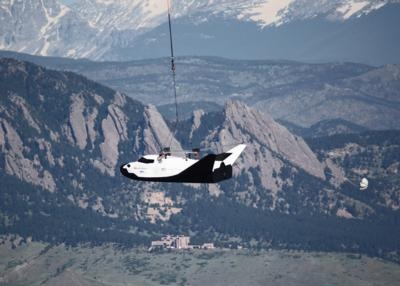Fri, Jun 08, 2012
Vehicle Designed To Transport Astronauts To ISS
The preliminary design review (PDR) of the design, architecture and performance of the Dream Chaser orbital crew vehicle has been completed by Sierra Nevada Corporation (SNC) Space Systems. This marks a milestone in the company's effort to develop transportation for astronauts to low Earth orbit and the International Space Station.

SNC is one of several companies working to develop commercial crew transportation capabilities under the Commercial Crew Development Round 2 (CCDev2) agreement with NASA's Commercial Crew Program (CCP). The goal is to help spur innovation and development of new spacecraft and launch vehicles from the commercial industry to develop safe, reliable and cost-effective capabilities to transport astronauts to low Earth orbit and the space station. The Dream Chaser is designed to carry as many as seven astronauts to space. It is the only spacecraft under CCDev2 that uses wings and is designed to land on a conventional runway.
"As CCP's partners meet these critical milestones, we are moving in the right direction in our combined effort to advance commercial capabilities that could eventually transport NASA astronauts," NASA CCP Program Manager Ed Mango said.
This marks the 17th milestone to be completed by SNC during CCP's initial two development phases. The PDR included a review of the entire orbital flight program, including the Dream Chaser spacecraft, and associated mission and ground systems. The company also reviewed the spacecraft's compatibility with its initial launch vehicle, the United Launch Alliance Atlas V rocket. "Our program includes 12 industrial partners, 7 NASA Centers and 3 universities from over 20 states who helped us achieve two major program milestones this week. With the completion of PDR and the beginning of our vehicle's flight test program, the Dream Chaser Program has now entered the next phase of its development. We are proud to be included with the other CCDev companies in developing a US crew capability to low earth orbit," said Mark Sirangelo, Corporate Vice President and head of SNC's Space Systems.
The final PDR board meeting was conducted shortly after the company successfully completed a captive-carry test of its full-scale Dream Chaser test flight vehicle May 29. The flight met all its test goals and moved the program a step closer to preparing the vehicle for an autonomous approach and landing test scheduled for later this summer. All of NASA's industry partners, including SNC, continue to meet their established milestones in developing commercial crew transportation capabilities.
NASA also is developing the Orion spacecraft and Space Launch System (SLS), a crew capsule and heavy-lift rocket that will provide an entirely new capability for human exploration beyond low Earth orbit. Designed to be flexible for launching spacecraft for crew and cargo missions, SLS and Orion will expand human presence beyond low Earth orbit and enable new missions of exploration across the solar system. (NASA image Dream Chaser during captive-carry test)
More News
Aero Linx: International Federation of Airworthiness (IFA) We aim to be the most internationally respected independent authority on the subject of Airworthiness. IFA uniquely combi>[...]
Ultrahigh Frequency (UHF) The frequency band between 300 and 3,000 MHz. The bank of radio frequencies used for military air/ground voice communications. In some instances this may >[...]
A Few Questions AND Answers To Help You Get MORE Out of ANN! 1) I forgot my password. How do I find it? 1) Easy... click here and give us your e-mail address--we'll send it to you >[...]
From 2019 (YouTube Edition): Learning To Paint Without Getting Any On Your Hands PPG's Aerospace Coatings Academy is a tool designed to teach everything one needs to know about all>[...]
Also: Sustainable Aircraft Test Put Aside, More Falcon 9 Ops, Wyoming ANG Rescue, Oreo Cookie Into Orbit Joby Aviation has reason to celebrate, recently completing its first full t>[...]
 ANN's Daily Aero-Linx (05.06.25)
ANN's Daily Aero-Linx (05.06.25) ANN's Daily Aero-Term (05.06.25): Ultrahigh Frequency (UHF)
ANN's Daily Aero-Term (05.06.25): Ultrahigh Frequency (UHF) ANN FAQ: Q&A 101
ANN FAQ: Q&A 101 Classic Aero-TV: Virtual Reality Painting--PPG Leverages Technology for Training
Classic Aero-TV: Virtual Reality Painting--PPG Leverages Technology for Training Airborne 05.02.25: Joby Crewed Milestone, Diamond Club, Canadian Pilot Insurance
Airborne 05.02.25: Joby Crewed Milestone, Diamond Club, Canadian Pilot Insurance



